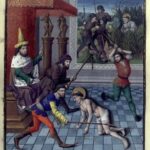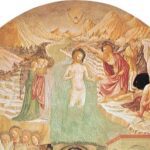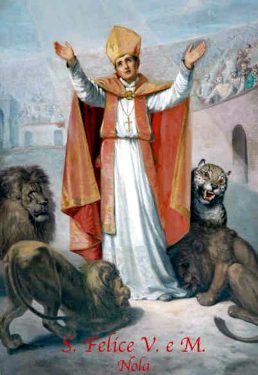St. Felix of Nola is a fascinating figure in Christian mythology, revered for his piety and miraculous deeds. His life story is a blend of history, legend, and faith, making him an essential character in the Christian tradition. Born in the 3rd century in Nola, a city in Campania, Italy, St. Felix lived during a tumultuous period for Christians. The Roman Empire was known for its persecution of Christians, and many believers faced great hardships. Despite these challenges, St. Felix’s unwavering faith and commitment to his community have made him a symbol of hope and resilience.
Early Life of St. Felix
St. Felix was born to a wealthy family, which provided him with a comfortable upbringing. However, his heart was drawn to a life of service and devotion to God. From a young age, he demonstrated a strong inclination towards the Christian faith. His parents, though initially supportive, grew concerned about his religious fervor. They hoped he would follow a more traditional path, but Felix felt a calling that he could not ignore. This early conflict set the stage for his future endeavors as a devoted Christian.
 St. Felix Iv
St. Felix IvAs he grew older, Felix became increasingly involved in the local Christian community. He participated in church activities and devoted much of his time to helping the less fortunate. His compassion for others was evident, and he earned a reputation as a kind-hearted and generous man. This reputation would later play a crucial role in his life, especially during the periods of persecution that Christians faced in the Roman Empire.
The Persecution of Christians
The time during which St. Felix lived was marked by intense persecution of Christians. The Roman authorities were determined to stamp out the growing faith, seeing it as a threat to their power and unity. Christians were often subjected to harsh punishments, including imprisonment, torture, and even execution. St. Felix, however, remained steadfast in his faith. He encouraged fellow Christians to stay strong and not lose hope in the face of adversity. His courage and resilience inspired many around him, fostering a sense of community among the beleaguered Christians.
During this period, St. Felix’s actions became increasingly bold. He would often go into hiding to escape the authorities, but he never abandoned his fellow Christians. Instead, he would visit them in secret, offering them support and encouragement. This behavior demonstrated his deep commitment to his faith and his fellow believers. Many accounts describe how he provided food and shelter to those who were in danger, showing a remarkable dedication to his community.
 St. Felix Iii
St. Felix IiiMiraculous Deeds
St. Felix is also known for the miraculous deeds attributed to him during his lifetime. These stories, while steeped in legend, reflect the deep faith and belief that the community had in him. One of the most famous miracles is the story of how he saved a group of Christians from persecution. When Roman soldiers were closing in on them, Felix is said to have prayed for their protection. In an astonishing turn of events, a sudden storm arose, causing the soldiers to retreat and allowing the Christians to escape unharmed. This event solidified Felix’s status as a holy man in the eyes of the community.
Another miraculous account involves Felix feeding the hungry. There is a story that describes how he once shared his meager provisions with a group of starving people. After praying over the food, it is said that there was enough for everyone, and they were all satisfied. This miracle not only showcases his compassion but also highlights the belief in divine intervention that characterized early Christian communities. Felix’s ability to perform miracles further endeared him to the people, reinforcing his role as a spiritual leader.
 St. Felix I
St. Felix ILife as a Hermit
Later in his life, St. Felix chose to live as a hermit, seeking solitude and deeper communion with God. This decision was not born out of a desire to escape his community but rather to dedicate himself fully to prayer and reflection. He retreated to the outskirts of Nola, where he lived in a small cave. Despite his isolation, Felix continued to be a source of inspiration for many. People would often come to visit him, seeking his wisdom and guidance. His hermitage became a sanctuary for those in need of spiritual support.
During this time, St. Felix’s reputation as a holy man continued to grow. Many believed that his prayers had the power to heal the sick and bring comfort to the troubled. His cave became a place of pilgrimage for those seeking miracles and blessings. The stories of his miraculous deeds spread far and wide, and people traveled from distant lands to seek his counsel. This period of his life exemplified the idea that solitude can lead to profound spiritual growth, and it reinforced his status as a beloved saint.
Death and Legacy
St. Felix passed away in the early 4th century, and his death was met with great sorrow by the community he had served so faithfully. The accounts of his passing describe a peaceful end, surrounded by those he had helped throughout his life. Following his death, the people of Nola honored him with a grand funeral, recognizing his contributions and the miracles he had performed. They buried him in the very cave where he had spent many years in prayer. This site later became a place of veneration for Christians.
Over the years, St. Felix’s legacy continued to thrive. He was canonized as a saint, and his feast day is celebrated on January 14th. His life and deeds have been recorded in various texts, and he is often depicted in art, showcasing his compassionate nature and miraculous abilities. St. Felix has become a symbol of faith, hope, and charity, inspiring countless individuals to live a life of service and devotion.
St. Felix in Art and Culture
The legacy of St. Felix of Nola has also made its way into various forms of art and culture. Throughout history, artists have sought to capture the essence of his life and the miracles attributed to him. Many paintings depict him surrounded by the needy, performing miracles or offering guidance. These artworks serve as a reminder of his compassionate spirit and the impact he had on those around him. St. Felix is often portrayed with symbols that represent his miraculous deeds, such as bread or a staff, further emphasizing his role as a provider and protector.
In literature, the stories of St. Felix have been recounted in various hagiographies, texts that detail the lives of saints. These writings serve not only as historical records but also as sources of inspiration for believers. The tales of his courage in the face of persecution and his dedication to serving others resonate with many, encouraging them to embody the same values in their lives. St. Felix’s life is a testament to the power of faith and the importance of community, making his story timeless.
Modern-Day Relevance
In today’s world, the life of St. Felix continues to hold relevance for many people. His commitment to helping others, especially those in need, is a powerful reminder of the importance of service and compassion. In a time when many face hardships, the stories of St. Felix inspire individuals to take action, whether through volunteering, supporting charitable causes, or simply being there for those in their community. His example encourages a spirit of altruism and kindness, which is essential for fostering a sense of unity and support among people.
Moreover, the miracles attributed to St. Felix serve as a source of hope for many believers. In times of uncertainty or despair, the stories of his divine interventions remind individuals that faith can lead to extraordinary outcomes. The teachings of St. Felix emphasize the power of prayer and the belief that one can make a difference in the lives of others. His legacy encourages people to remain steadfast in their beliefs and to trust in the possibility of miracles, no matter how challenging their circumstances may be.
Celebrations and Commemorations
St. Felix’s feast day on January 14th is celebrated in various ways around the world. Many churches hold special services to honor his memory, and some communities organize festivals that include processions, prayers, and gatherings. These celebrations serve to bring people together, fostering a sense of community and shared faith. They also provide an opportunity for individuals to reflect on the values that St. Felix embodied, such as charity, humility, and dedication to God.
In some regions, the celebrations are marked by traditional foods and activities that reflect the local culture. This blending of religious observance with cultural practices enhances the communal experience, allowing people to connect with their heritage while honoring a beloved saint. The stories and teachings of St. Felix are often shared during these gatherings, ensuring that his legacy continues to inspire future generations.
The life and legacy of St. Felix of Nola stand as a powerful testament to the enduring spirit of faith and service in the Christian tradition. His story is one of resilience in the face of adversity, compassion for the needy, and the miraculous power of belief. As people continue to celebrate his life and teachings, St. Felix remains a beacon of hope and inspiration for all who seek to live a life of love and service to others.
